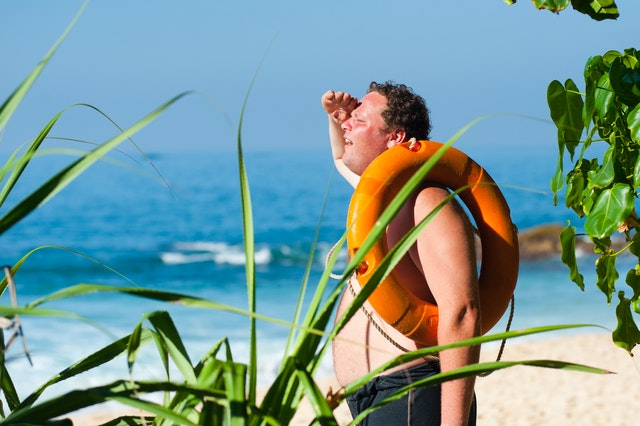Heat stroke has been on the rise. With climate changes, hotter and longer summers are being noticed in many places in the world. June 2022 has turned out to be the fourth-hottest month ever recorded — globally with more heat waves on the horizon, and a big one currently sweeping the UK. The risk of heat-related health problems has also been on the rise.
What is The Pathophysiology of Heat Illness?
To understand heat stroke it’s important to understand the abnormal body changes associated with heat illness. The concept of heat input and output.
The heat input comes from
- The environment.
- Metabolism.
While Heat output occurs through the skin via the following:
- Radiation: Transfer of body heat directly into a cooler environment by infrared radiation, a process that does not require air motion or direct contact.
- Evaporation: Cooling by water vaporisation (e.g., sweat).
- Convection: Transfer of heat to cooler air (or liquid) that passes over exposed skin.
- Conduction: Transfer of heat from a warmer surface to a cooler surface that is in direct contact.
The contribution of each of these mechanisms varies with environmental temperature and humidity.
When temperature of the environment is lower than body temperature:
- Radiation provides 65% of cooling.
- Evaporation provides 30% of cooling and
- Exhalation of water vapour and production of urine and faeces provide about 5%.
When environmental temperature is > 35°C or 95°F, evaporation accounts for virtually all dissipation of heat because the other mechanisms function only when environmental temperature is lower than body temperature. However, effectiveness of sweating is limited. Sweat that drips from the skin is not evaporated and does not contribute to cooling.
Effectiveness of sweating is also function of the body surface area and humidity
When humidity is > 75%, evaporative heat loss markedly decreases. Thus, if both environmental temperature and humidity are high, all mechanisms for heat dissipation are lost, markedly increasing risk of heat illness results.
The body can compensate for large variations in heat load, but significant or prolonged exposure to heat that exceeds capacity for heat dissipation increases the core temperature. Modest, transient core temperature elevations are tolerable, but severe elevations (typically > 41° C or 105.8F) lead to:
- Protein denaturation and, especially during hard work in the heat. Proteins has a unique 3 dimensional structure but due to changes in temperature, pH or other chemical activities, the hydrogen bonds present in the proteins get disturbed.
- Release of inflammatory cytokines (e.g., tumor necrosis factor alpha, IL-1b). As a result, cellular dysfunction occurs and the inflammatory cascade is activated, leading to dysfunction of most organs and activation of the coagulation cascade. These conditions are similar to the processes seen in multiple organ dysfunction syndromesin prolonged shock.

Compensatory mechanisms include vis:
- An acute-phase response by other cytokines that moderate the inflammatory response (e.g., by stimulating production of proteins that decrease production of free radicals and inhibit release of proteolytic enzymes).
- Increased core temperature triggers expression of heat-shock proteins. These proteins transiently enhance heat tolerance by poorly understood mechanisms (e.g., possibly by preventing protein denaturation) and by regulation of cardiovascular responses.
With prolonged or extreme temperature elevation, compensatory mechanisms are overwhelmed or malfunction, allowing inflammation and multiple organ dysfunction syndromes to occur.
How Does The Body React to Increased External Temperatures?
The body’s normal core temperature is 37-38°C.The healthy human body maintains its internal temperature around 37°C. Variations, usually of less or more than 1°C, can occur.
As the external temperature rises, the body’s temperature increases as well. The body’s internal “thermostat” maintains a constant inner body temperature by:
- Increasing the heartbeat – This pumps more blood to the cutaneous blood vessels in skin. The cutaneous blood flow is about 200 to 250 mL/minute at normal temperatures but increases to 7 to 8 L/minute with heat stress and this facilitates heat loss by convective, conductive, radiant and evaporative mechanisms).
This results in a marked increase in cardiac output with the release of some extra heat as a result. This arrangement causes a reduction of blood flow to some parts of the body leading to tiredness and sluggishness especially when physical or mental work is done.
- By increasing sweat production – as the air absorbs the sweat (evaporation), it draws the heat away and cools down the body. In this way, the body increases the rate of heat loss to balance the heat burden.
Heat stress increases sweat production from negligible to > 2 L/hour; however, the sweat that is dripped from the skin does not contribute to cooling, it only contributes to dehydration.
Significant sweating can occur less perceptibly in very hot, very dry air, in which sweat evaporates very quickly. With sweat production of > 2 L/hour, dehydration develops very rapidly.
When the temperature is hot, sweating occurs thus resulting in losing fluids and electrolytes. Electrolyte loss may be substantial. However, prolonged exposure triggers physiologic changes to accommodate heat load this is called acclimatisation e.g., sweat sodium levels are at 40 to 100 mmol/L in people who are not acclimatised but decrease to 10 to 70 mmol/L in acclimatised persons.
- Dilatation of the blood vessels – In addition, heat makes the blood vessels to dilate and increase sweating. These drops the blood pressure; sometimes resulting in dizziness or feeling of passing out.
In a very hot environment, the rate of “heat gain” is more than the rate of “heat loss” and the body temperature begins to rise. A rise in the body temperature results in heat illnesses, which encompasses a number of disorders ranging in severity from musclecramps and heat exhaustion to heat stroke which can be very serious.
What is Heat Stroke?
Heatstroke is said to occur when the compensatory mechanisms for dissipating heat described above fail and core temperature increases substantially leading to inflammatory cytokines being activated, and multiple organ dysfunction develops.
So is it the heat or humidity that is the real killer?
The humidity is a huge factor. If there is a tremendously high temperature and high humidity sweating occurs but the sweat won’t be drying on the skin. That’s why it’s not just heat but the combination of heat and humidity that matter. Obviously there are thresholds for both temperature and humidity above which we see an increase in death.
Types of heat stroke
There are two types of heatstroke:
-
Exertional heat stroke
This form of heatstroke is usually the result of physical overexertion in hot, humid conditions. It can develop in a few hours.
-
Non-Exertional heat stroke
Also called classic heatstroke. This type can occur due to age or underlying health conditions. It tends to develop over several days. Heat stroke may also occur after using certain drugs (e.g., cocaine, phencyclidine [PCP], amphetamines, monoamine oxidase inhibitors) that cause a hyper metabolic state.
Usually, an overdose is required, but exertion and environmental conditions can be additive.
Heat stroke Symptoms and Signs
- Central nervous system (CNS) dysfunction, ranging from
- Confusion or bizarre behavior to delirium.
- Seizures.
- Coma, the hallmark of heatstroke.
- Ataxia may be an early manifestation.
- Increased heart rate (tachycardia) even when the patient is supine.
- Increased breathing (tachypnea) is common.
- Sweating may be present or absent.
- Temperature is > 40° C or 104 F
Diagnosis
- Clinical evaluation, including core temperature measurement.
- Laboratory testing for organ dysfunction includes
- Complete blood count.
- Prothrombin time (PT).
- Partial thromboplastin time (PPT).
- Electrolytes, blood urea nitrogen, creatinine.
- Calcium.
- Creatine kinase (CK)- if elevated, myoglobinuria is likely to be done.
- Hepatic profile to evaluate organ function.
- Urine-A urethral catheter is placed to obtain urine
- Urinalysis(occult blood)
- Urine output monitoring.
- Urine drug screening.
Diagnosis is usually clear from a history of exertion and environmental heat. When the diagnosis of heatstroke is not obvious, other disorders that can cause CNS dysfunction and hyperthermia should be considered.
These disorders include the following:
- Acute infection (e.g., sepsis, malaria, meningitis, toxic shock syndrome)
- Drugs
- Serotonin Syndrome.
- Status epilepticus (A seizure that lasts longer than 5 minutes, or having more than 1 seizure within a 5 minutes period, without returning to a normal level of consciousness between episodes)
- Stroke.
- Thyroid storm.
Continual monitoring of core temperature, usually by rectal, esophageal, or bladder probe, is desired.
What is the Difference Between Heat Stroke and Heat Exhaustion?
Heat exhaustion is a non-life threatening clinical syndrome of weakness, malaise, nausea, syncope and other non-specific symptoms caused by exposure to heat.
Here, the Central Nervous system (CNS) and the heat regulatory mechanisms are not impaired and patient may have an elevated body temperature of more than 40C and with resting, a cool environment and fluid replacement, the patient recovers.
Heatstroke is thus differentiated from heat exhaustion by presence of the:
- CNS dysfunction and
- Failure of the thermoregulation.
Preventive Measures
To help prevent heat exhaustion or heat stroke:
- Drink plenty of cold drinks, especially when exercising.
- Take cool baths or showers.
- Wear light-colored, loose clothing.
- Sprinkle water over skin or clothes.
- Avoid the sun between 11am and 3pm.
- Avoid excess alcohol.
- Avoid extreme exercise.
This will also prevent dehydration and help the body keep itself cool. Children, the elderly and people with long-term health conditions (like diabetes or heart problems) should be monitored closely, because they’re more at risk of heat exhaustion or heat stroke.
Treatment of Heat Stroke
Classic and Exertional heatstrokes are treated similarly. The importance thing is recognition and effective, aggressive cooling and supportive measured cannot be overemphasised.
 Treatment of Heat stroke is of 2 approaches vis:
Treatment of Heat stroke is of 2 approaches vis:
- Aggressive cooling
This can be achieved by vis
-
- Cold-water immersion – This result in the lowest morbidity and mortality rates and is the treatment of choice when available.
The rate of heat loss during cooling may be decreased by vasoconstriction and shivering, although benzodiazepine e.g. Diazepam takes care of this.
-
- Evaporative cooling – Evaporative cooling is more effective when using warm rather than cold water. Warm water maximizes skin-to-air vapor pressure gradient and minimizes vasoconstriction and shivering.
Some specially designed body cooling units suspend patients naked on a net over a drainage table while finely misted water at 15°C or 59°F is sprayed over the entire body from above and below. Fans are used to circulate air warmed to 45 (113°F) to 48° C (118.4°F) around the body. With this technique, most patients who have heatstroke can be cooled in < 60 minutes.
In addition, ice or chemical cold packs can be applied to the neck, axillae, and groin or to hairless skin surfaces (i.e., palms of hands, soles of feet, cheeks) that contain densely packed subcutaneous vessels to augment cooling, but are not adequate as the sole cooling method.
- Aggressive supportive care
- The patient is admitted to an intensive care unit (ICU), and IV hydration with 0.9% saline solution is stated.
- to 2 L of IV 0.9% saline cooled to 4°C or 39°F, as used in protocols to induce hypothermia after cardiac arrest, may also help decrease core temperature.
- Endotracheal intubation and mechanical ventilation may be needed to prevent aspiration.
- Supplemental Oxygen.
- Organ dysfunction is treated.
- Injectable benzodiazepine may be used to prevent agitation and to treat seizures (which increase heat production).
- Platelets and fresh frozen plasma may be required for severe Disseminated intravascular coagulation (DIC)
- If myoglobinuria is present, enough fluids are given to maintain urine output of ≥ 0.5 mL/kg/hour.
- IV sodium Bicarbonate to alkalinise the urine can help prevent or minimise nephrotoxicity.
- IV calcium salts may be necessary to treat hyperkalemic cardiotoxicity.
- Vasoconstrictors are used to treat low blood pressure, which may reduce cutaneous blood flow and decrease heat loss. When vasoconstrictors are used in an ICU, a pulmonary artery catheter may be used to monitor filling pressures.
Please note that fever reducers are of no value and may contribute to liver or kidney damage. Activated protein C shows promising results in animal models, but is unproven in humans
Conclusion
Heat stroke is the most serious heat-related illness and is considered a medical emergency. It occurs when the body can no longer control its temperature: the body’s temperature rises rapidly, the sweating mechanism fails, and the body is unable to cool down.
When heat stroke occurs, the body temperature can rise to 106°F or higher within 10 to 15 minutes. Heat stroke can cause permanent disability or death if the person does not receive emergency treatment.



